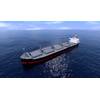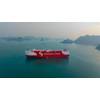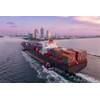Most Powerful Offshore Wind Turbine Erected
Swiss multinational equipment manufacturer Liebherr Group said that its cranes erected the prototype of what is currently the most powerful offshore wind turbine in the world in the Dutch port of Rotterdam.
The gondola of the wind turbine, which measures an overall 207 meters in height, has a net weight of 675 tonnes. It was the heaviest load for the two Liebherr crawler cranes used for the job. In a tandem hoist, the two LR 11350 cranes managed a gross load of 780 tonnes and placed the massive component onto the 150 meter tower for the gigantic turbine.
General Electric (GE) unveiled this 12 Megawatt with the name “Haliade-X 12 MW” in October, making it currently the most powerful wind turbine in the world for offshore use.
The massive tower and the complete gondola with its gigantic dimensions of around 1500 cubic meters surrounding sophisticated technology was installed at the port of Rotterdam during the summer. The prototype was erected on land to make access to the system easier during the test phase.
Dutch and global heavy haulage and special transport group Mammoet, which had won the order to erect this wind turbine, used two LR 11350 cranes from Danish crane contractor BMS to erect the 12 Megawatt system, using tandem hoists in some cases. One of the two crawler cranes came straight from the production line at the Liebherr plant in Ehingen to the site.
This crane job with an extraordinarily heavy load was absolutely ideal for the set-up for the two crawler crane shown here – the Power-Boom system to increase lifting capacity, for which the main boom is doubled at the bottom, increases the capacity of the lifting gear massively.
The upright boom position required in Rotterdam and a boom length of 150 meters meant that this system increased the lifting capacity of these Liebherr cranes by over 70 percent compared to a standard lattice boom system.
As so often on wind power sites, the weather here at the port of Rotterdam dictated the timetable for the major hoists. For example to install the gigantic gondola, the load was positioned between the two crawler cranes for more than two days until the wind conditions finally allowed them to complete the hoist onto the 150 meter high tower.
The 675 tonne heart of the system then required around one hour to cover the route to its final position. With the enormous special cross beams and the lifting tackle, the two crawler cranes had to manage a total load of 780 tonnes.
After reaching the final height, the crawler carriers carefully started to move – the two LR 11350 cranes had to move around 20 meters with the load on their hooks until the gondola could be positioned precisely on the tower.
Only one of the two cranes had to remain in Rotterdam to install the 107 meter rotor blades a few weeks later. The system was finally completed by the end of October. According to the manufacturer, a turbine of this type should be able to generate 67 Gigawatt hours of electricity every year. That corresponds to the consumption of around 16,000 households.
Related News





